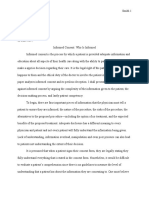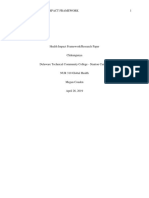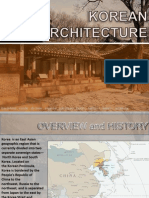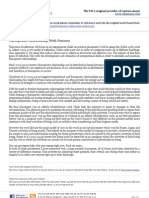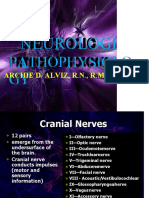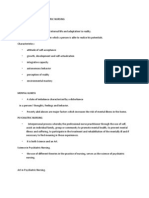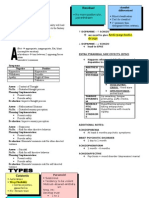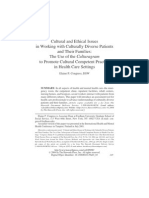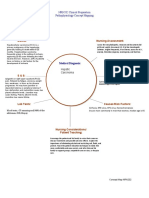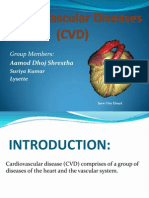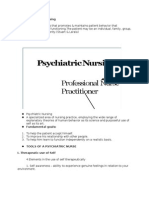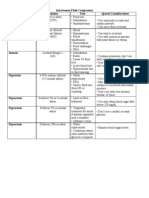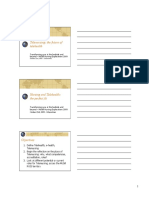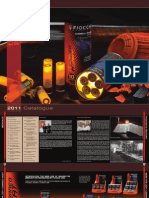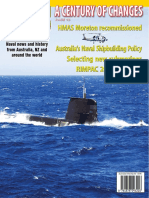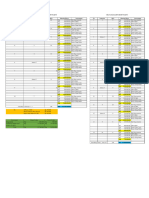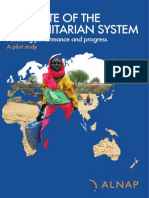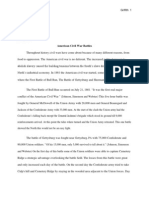Triage
Triage
Uploaded by
Sarah GuintoCopyright:
Available Formats
Triage
Triage
Uploaded by
Sarah GuintoCopyright
Available Formats
Share this document
Did you find this document useful?
Is this content inappropriate?
Copyright:
Available Formats
Triage
Triage
Uploaded by
Sarah GuintoCopyright:
Available Formats
TRIAGE: - To sort - Medical needs and urgency of each individual patient - Sorting based on limited data acquisition - Consider
resource availability MILITARY VS CIVILIAN Military Priority is to get as many soldiers back into actions as possible serious wounds -> the first treatment priority
Civilian Priority is to maximize the survival of the greatest number of victims those with the most serious but realistically salvageable injuries are treated first
In both models, victims with lethal injuries or unlikely to survive even with extensive resource application are treated as the lowest priority ETHICAL JUSTIFICATION Utilitarian rule - Greater good of the greater number rather than particular good of the patient at hand. - Justified only because of clear necessity of general public welfare in a crisis Why should responders care about good triage? - Provides a way to draw organization out of chaos - Helps to get care to those who need it and will benefit from it the most - Helps in resource allocation - Provides an objective framework for stressful and emotional decisions Importance of Resources - Disaster is commonly defined as an incident in which patient care needs overwhelm local response resources - Daily emergency care is not usually constrained by resource availability Abundant resources relative to demand (R Patient) *Resources challenged Daily emergencies - do the best for each individual Disaster Settings - Do the greatest good for the greatest number. Maximize survival rate Triage is a dynamic process and id usually done more than once I. Primary Disaster Triage (PRIORITIZATION) Goal: - to sort patients based on probable needs for immediate care - To recognize futility Assumptions: - Medical needs outstrip immediately available resources - Additional resources will become available with time Triage based on physiology: - How well the patient is able to utilize their own resources to deal with their injuries - Which conditions will benefit the most from the expenditure of limited resources
The most commonly used adult tool in US and Canada is START tool (Simple Triage and Rapid Treatment) The only recognized pediatric MCI primary triage tool is the JumpSTART tool Other tools exist but are used for small
Basic Disaster Life Support www.dmou.org MASS Triage (Move, Assess, Sort, Send) - Assessment guidelines - Pediatric considerations - No MCI primary triage tool validated II. Secondary Disaster Triage (ALLOCATING RESOURCES) Goal: to nest match patients current and anticipated needs with available resources Incorporates - A reassessment of physiology - Assess Physical injuries - Initial treatment and assessment of patient response - Further knowledge of resource availability SAVE Tool (Secondary Assessment of Victim Endpoint) California EMS NATO Guidelines (Traffic lights) Red - Immediate priority - Airway obstructions, Cardiorespiratory failure, significant ext hemorrhage, shock, sucking chest wound, burns of face and neck Yellow - Delayed - Open thoracic wound, penetrating abdominal wound, severe eye injury, avascular limb fractures, significant burns other than face, neck or perineum Green - Minor, Walking wounded - Minor lacerations, contusions, sprains, superficial burns, partial thickness burns less 20% BSA Black - Expectant or dead, No vital signs - Head injury with GCS less 8, burns 85% BSA, multisystem trauma, massive blood loss - Provide comfort care Secondary Triage Goal: Identify victims - Needing life saving treatment, can only be provided in hospital settings - Need life saving treatment initially available on scene - With moderate non-life threatening, at risk for delayed complications - With minor injuries III. Tertiary Disaster Triage
Goal: Optimize individual outcome Incorporates: - Sophisticated assessment and treatment - Further assessment of available medical resources - Determination of best venue for definitive care MCI Triage Key points: - Resources and patient number acuity are limiting factors - No definite tool used
START TRIAGE
RPM R 30 P 2 M Can do Modification for nonambulatory children - Developmentally unable to walk and disabled do not force to walk (-_-) Duh of course. - Assess using JumpSTART - Tag depending on the applicable criteria Green, Yellow, Red, Black
What about WMD (Weapons of Mass Destruction) There is no widely recognized civilian MCI triage tool used in the US for any NRBC agents Must consider decontamination: - Who goes first? - What stage does triage take place? - Difficulty of conducting patient assessment and care with responders in protective gear WMD Triage Challenges (Weapons of Mass Destruction) - Agents of attack may be mixed. How do you triage victims who have injuries from a conventional attack in addition to a chemical or radiological/nuclear exposure? - NIological agents may impact fiel triage mostly in choice of destination facility (quarantine hospital) - Patterns of EMS calls may assist in identification of a occult biological agent attack or natural epidemic - Biosurveillance tool - Some agents cause toxindromes that allow or prediction of outcome based on presenting symptoms and signs - Agent-specific triage is dependent upon identification or strong suspicion of agents use - Very difficult to train and maintain readiness with multiple agent-specific triage schemes
Chemical Toxindrome Examples Nerve Agent: - Red: severe distress, seizure, signs in two or more systems (neuro, GI, respi excluding eyes and nose) - Black: pulseless or apneic, unless intensive resources are available Phosgene and vesicants: - Red: moderate to sever RD, only when intensive resources are immediately available - Black: burns >50% BSA form liquid exposure, signs of more than minimal pulmonary involvement, when intensive resources are available Cyanide Displaces oxygen hypoxia - Red: active seizure, recent onset of apnea with preserved circulation - Black: no palpable pulse http://www.bordeninstitute.army.mil/cwbw/CH14.pdf Key points about MCI triage - anything that can help organize the response to an MCI is a good thing - MCI triage Is different than daily triage, in both field and ED settings - Resource availability is the limiting factor to consider in MCI triage - All victims must have equal importance at the time of primary triage, this includes children - Disaster research agendas should include efforts to validate and improve existing triage tools www.jumpstarttriage.com Managing MCI - Loss of lives results from inefficient mobilization of resources - The community is the first to provide emergency assistance during emergencies and disasters resulting in large number of injuries - Attention was given to the training for emergency personnel in first aid or first responders - First responders were trained to provide victims with basic triage and field care before evacuation to the nearest health facility Ozone Disco Tragedy 1996 Lung Center Fire 1998 Manor Hall incident 200MCI defined as an event resulting in a bumber of victims large enough to disrupt the normal course of emergency and health care services - Low impact - High impact - Terrorism The most sophisticated approach, including pre-established procedures for resource mobilization, field management and hospital reception Impact Zone Field/Pre-hospital management (utilize resource mobilization) Hospital Reception and Management
MIC Management First Responders first medically trained responder to arrive on the scene Second Responders vital to the restoration of the disaster sites FIRST RESPONDERS - Bureau of Fire - National Security - Emergency Medical Services SECOND RESPONDERS - Skilled construction workers - Police - Fire - Volunteers - Other responders Characteristics: - Incorporates linkages between field and health care facilities through a command post GOAL: Good of the majority (utilitarianism) Challenges: - Availability of resources - Efficiency of responders LEGAL BASIS - Department of Health A.O. 155 2004 o Known as Implementing Guidelines for Managing Mass Casualty Incidents during Emergencies and Disasters o Reduce possible loss of life and prevent disability in cases of MCI o Components: Operations and Dispathc Field Management Safety Measures Victim Management MANAGING MASS GATHERINGS Preparing for Mass Gatherings 1. Risk Assessment 2. Surveillance (How will we know when it happens) 3. Response (what will we do when it happens) Establish partnerships
Mass gatherings can cause: - Increase in the level of existing risks - Pose entirely new risks Major anticipated health risks: - Heat or cold related illness - Foodborne and waterborne illnesses
Communicable diseases Accidents and Injuries INJURIES AND PANIC RELATED, Trauma GI Heart problem
Strategies to reduce risks - Mass gatherings make responding to illnesses and injuries more difficult - Challenges in risk reduction includes: o Greater than usual movement of people o More interaction among large numbers of people in confined areas o Greater impact and stress on local infrastructure systems o Higher levels of chaors and confusion
You might also like
- Status Epilepticus Case Study Kristopher Kirby.Document4 pagesStatus Epilepticus Case Study Kristopher Kirby.KrisNo ratings yet
- Alpha Legion Hydra DominatusDocument1 pageAlpha Legion Hydra DominatusRichter SnellingNo ratings yet
- FR350 50 2Document130 pagesFR350 50 2Stephen SmithNo ratings yet
- Access, Cost, and Quality For APNsDocument6 pagesAccess, Cost, and Quality For APNsMellyne SallyNo ratings yet
- Case StudyDocument6 pagesCase StudyMarie-Suzanne Tanyi100% (1)
- Post Op Case Studies StudentsDocument19 pagesPost Op Case Studies StudentsRenie SerranoNo ratings yet
- Acute Coronary SyndromeDocument4 pagesAcute Coronary SyndromeHaryaman JustisiaNo ratings yet
- Biomedical Final PaperDocument6 pagesBiomedical Final PaperMiss DNo ratings yet
- PICOTDocument8 pagesPICOTRaphael Seke OkokoNo ratings yet
- Couden - Final Chikungunya Health Impact Framework PaperDocument15 pagesCouden - Final Chikungunya Health Impact Framework Paperapi-449016836100% (1)
- Korean ArchitectureDocument101 pagesKorean ArchitectureMaimai Rea Conde100% (4)
- CHN Review March 1 2011 CompleteDocument61 pagesCHN Review March 1 2011 CompletekrezeojNo ratings yet
- Atun Maricris Jorre Ca2 Au Legarda Leadership Managemet Research DownloadableDocument2 pagesAtun Maricris Jorre Ca2 Au Legarda Leadership Managemet Research DownloadableCharissa Magistrado De LeonNo ratings yet
- Therapeutic Relationship PatientDocument6 pagesTherapeutic Relationship Patientdamcon7No ratings yet
- RODRIGUEZ, Marion Patricia L. 1E L-1800073Document2 pagesRODRIGUEZ, Marion Patricia L. 1E L-1800073Patricia RodriguezNo ratings yet
- Nursing Case CadDocument26 pagesNursing Case CadShield DalenaNo ratings yet
- Neuro HandoutDocument22 pagesNeuro HandoutCharme Jean RaygonNo ratings yet
- Nursing ShortageDocument10 pagesNursing Shortageالأغا محمد زكارنةNo ratings yet
- Nursing Practice IDocument45 pagesNursing Practice IWilmaBongotanPadawilNo ratings yet
- Health Teachings On CHFDocument6 pagesHealth Teachings On CHFfLOR_ZIANE_MAENo ratings yet
- The Nursing ShortageDocument6 pagesThe Nursing Shortageapi-455495817No ratings yet
- Duty Ob ExamDocument3 pagesDuty Ob ExamKATHERINE GRACE JOSENo ratings yet
- Basic Concepts in Psychiatric NursingDocument10 pagesBasic Concepts in Psychiatric NursingKhristine Paladan ZernaNo ratings yet
- Care of Adults 26 Endocrine ManagementDocument26 pagesCare of Adults 26 Endocrine ManagementGaras AnnaBerniceNo ratings yet
- Which of The Following Statements by The Nurse WouldDocument7 pagesWhich of The Following Statements by The Nurse WouldFreeNursingNotesNo ratings yet
- Leadershp Strategy Analysis Paper FinalDocument10 pagesLeadershp Strategy Analysis Paper Finalapi-240099055No ratings yet
- Describing The System: Components and TermsDocument3 pagesDescribing The System: Components and TermsimnasNo ratings yet
- Vasquez - RLE A3 - PCCR (OSMUN Ward)Document16 pagesVasquez - RLE A3 - PCCR (OSMUN Ward)Mari Sheanne M. Vasquez100% (1)
- Schizophrenia PDFDocument32 pagesSchizophrenia PDFJoyVee Pillagara-De LeonNo ratings yet
- Grand Case Presentation (MI, COPD and BPH)Document80 pagesGrand Case Presentation (MI, COPD and BPH)Sarah Lim100% (2)
- Nurs 3020 Final EvalDocument9 pagesNurs 3020 Final Evalapi-312968341No ratings yet
- Lecture Aid: Mental Health and Psychiatric Nursing 1: Lester R. L. LintaoDocument14 pagesLecture Aid: Mental Health and Psychiatric Nursing 1: Lester R. L. LintaoEsarpy (Nana)No ratings yet
- Course Description: 3. Communities (Community Service)Document35 pagesCourse Description: 3. Communities (Community Service)April Mae Magos LabradorNo ratings yet
- Residual: No More Positive S/SX, Just WithdrawnDocument10 pagesResidual: No More Positive S/SX, Just WithdrawnRosie CuasitoNo ratings yet
- Cultural and Ethical Issues in Working With Culturally Diverse Patients and Their Families The Use of The Culturagram To Promote Cultural Competent Practice in Health Care SettingsDocument14 pagesCultural and Ethical Issues in Working With Culturally Diverse Patients and Their Families The Use of The Culturagram To Promote Cultural Competent Practice in Health Care Settingslagaanbharat100% (1)
- Nurse's Safety Attitudes As Perceived by Geriatric Patients in Homecare InstitutionsDocument16 pagesNurse's Safety Attitudes As Perceived by Geriatric Patients in Homecare InstitutionsGlobal Research and Development ServicesNo ratings yet
- Disaster Nursing - Icn Position and Recommendation - Rotone, Lycah v. - BSN 4yb-4Document3 pagesDisaster Nursing - Icn Position and Recommendation - Rotone, Lycah v. - BSN 4yb-4Lycah RotoneNo ratings yet
- Nursing Care PlanDocument44 pagesNursing Care PlanBiway RegalaNo ratings yet
- Community Health Nursing ReviewerDocument10 pagesCommunity Health Nursing ReviewerNicole CastillaNo ratings yet
- Nervous System Diseases and DisordersDocument88 pagesNervous System Diseases and DisordersJape GarridoNo ratings yet
- Culture+and+Health+Care Reaction+Paper+1Document5 pagesCulture+and+Health+Care Reaction+Paper+1Janeel CowanNo ratings yet
- Chloe - Paper 1Document7 pagesChloe - Paper 1api-458494853No ratings yet
- GROUP 3 - CASE STUDY - TraumaDocument5 pagesGROUP 3 - CASE STUDY - TraumaDinarkram Rabreca EculNo ratings yet
- Transcultural InterviewDocument13 pagesTranscultural InterviewChelsea RuthrauffNo ratings yet
- Maternal & Child Health NursingDocument22 pagesMaternal & Child Health Nursingtoledanagerald516No ratings yet
- NRN 202 Concept Map Patho-Hepatic CarcinomaDocument1 pageNRN 202 Concept Map Patho-Hepatic CarcinomaWendy GilbertNo ratings yet
- CVDDocument25 pagesCVDSameer ValsangkarNo ratings yet
- CD Exams and RationaleDocument4 pagesCD Exams and RationaleGilbert SalacupNo ratings yet
- Leadership FinalDocument7 pagesLeadership Finalapi-310557802No ratings yet
- NUR100 Sherpath CH 3 Community Based Nursing Public Health NursingDocument12 pagesNUR100 Sherpath CH 3 Community Based Nursing Public Health Nursingcaloy2345caloyNo ratings yet
- Psychiatric Nursing 1Document17 pagesPsychiatric Nursing 1Marichu BajadoNo ratings yet
- CHN Post TestDocument2 pagesCHN Post TestArvinjohn GacutanNo ratings yet
- Practice Marketing Plan FinalDocument14 pagesPractice Marketing Plan Finalapi-317365152No ratings yet
- Competency Appraisal Midterm ExaminationsDocument9 pagesCompetency Appraisal Midterm ExaminationsRellie Castro100% (1)
- Emergency RoomDocument2 pagesEmergency Roomapi-508765756No ratings yet
- Nur 310 Hif PaperDocument8 pagesNur 310 Hif Paperapi-709819870No ratings yet
- Intravenous FluidDocument2 pagesIntravenous FluidhanyakleinNo ratings yet
- Nurs 3021 - Clinical Reflective JournalDocument5 pagesNurs 3021 - Clinical Reflective Journalapi-505854426No ratings yet
- Interaction AnalysisDocument2 pagesInteraction Analysisapi-302499446No ratings yet
- Telenursing PDFDocument10 pagesTelenursing PDFSujatha J JayabalNo ratings yet
- The Ride of Your Life: What I Learned about God, Love, and Adventure by Teaching My Son to Ride a BikeFrom EverandThe Ride of Your Life: What I Learned about God, Love, and Adventure by Teaching My Son to Ride a BikeRating: 4.5 out of 5 stars4.5/5 (2)
- Learning to Heal: Reflections on Nursing School in Poetry and ProseFrom EverandLearning to Heal: Reflections on Nursing School in Poetry and ProseNo ratings yet
- Target KET For Schools TBDocument101 pagesTarget KET For Schools TBjuan2700No ratings yet
- 2011 Fiocchi USA CatalogueDocument31 pages2011 Fiocchi USA CatalogueMario LopezNo ratings yet
- THE Revolt in The Warsaw Ghetto: William ZukermanDocument4 pagesTHE Revolt in The Warsaw Ghetto: William ZukermanHirshel Tzig100% (1)
- 4 Indian Division 1941Document3 pages4 Indian Division 1941john_crawford_1No ratings yet
- One of The Themes of The Play Is FeDocument1 pageOne of The Themes of The Play Is Fepcfreelancing8No ratings yet
- Aircraft Design Notes 1Document71 pagesAircraft Design Notes 1Harshil NaikNo ratings yet
- Extension Letter - Central Mindanao UniversityDocument3 pagesExtension Letter - Central Mindanao UniversitykeithNo ratings yet
- Standard Api Tank Sizes PDFDocument2 pagesStandard Api Tank Sizes PDFEko SuherNo ratings yet
- Laporan Harian Vaksin Covid-19 Puskesmas "Singojuruh"Document27 pagesLaporan Harian Vaksin Covid-19 Puskesmas "Singojuruh"Agus SuyonoNo ratings yet
- Clone Wars Adventures Volume 4 Discussion - Jedi Council ForumsDocument1 pageClone Wars Adventures Volume 4 Discussion - Jedi Council ForumsajacksonxdNo ratings yet
- Datafortress 2020 - Interlock Unlimited - CP2020 GM ScreenDocument23 pagesDatafortress 2020 - Interlock Unlimited - CP2020 GM ScreenFabricio MoreiraNo ratings yet
- Keppetipola Disawe - WikipediaDocument6 pagesKeppetipola Disawe - WikipediaRubi ChakrabortyNo ratings yet
- AP 8 2nd Quarter Reviewer With Answer KeyDocument10 pagesAP 8 2nd Quarter Reviewer With Answer Keymarcjustin.amurao1No ratings yet
- HistDocument4 pagesHistusamaNo ratings yet
- Clear The Mines: Table Set UpDocument3 pagesClear The Mines: Table Set UpmystericeNo ratings yet
- Codex: Necrons Faq V4.0.1: Using This UpdateDocument2 pagesCodex: Necrons Faq V4.0.1: Using This UpdateDurinUndyingNo ratings yet
- HSC 2012: La Liste Des 500 ClassésDocument30 pagesHSC 2012: La Liste Des 500 ClassésDefimediagroup Ldmg100% (1)
- Australian Warship 93 PDFDocument64 pagesAustralian Warship 93 PDFcadagp100% (2)
- Biaya Penuh Dan Paruh Waktu SiberMuDocument1 pageBiaya Penuh Dan Paruh Waktu SiberMuIlham Kurniawan, S.IPNo ratings yet
- Wargames Illustrated #070Document60 pagesWargames Illustrated #070Анатолий Золотухин100% (1)
- Music APA SampleDocument8 pagesMusic APA SampleModie MasangkayNo ratings yet
- 30th (Cambridgeshire) Regiment of Foot: HistoryDocument6 pages30th (Cambridgeshire) Regiment of Foot: Historyfortea92No ratings yet
- 30 mmHEIDocument3 pages30 mmHEILG GLNo ratings yet
- State of Humanitarian SystemDocument76 pagesState of Humanitarian SystemvthiseasNo ratings yet
- Death RattleDocument9 pagesDeath Rattleapi-282968358No ratings yet
- History HKDSE (First Year) Summary 1Document8 pagesHistory HKDSE (First Year) Summary 1hcat5581No ratings yet
- American Civil War BattlesDocument3 pagesAmerican Civil War BattlesJames D GriffithNo ratings yet







